A Feasibility Report on Virtual Surgery in Remote Queensland Areas
VerifiedAdded on 2023/06/05
|27
|6934
|487
Report
AI Summary
This report investigates the feasibility of implementing virtual surgery in remote areas of Queensland to address the challenges of providing quality surgical procedures to residents with limited healthcare access. It explores the potential of virtual reality and virtual environments for surgical education, training, and planning, highlighting the benefits of 3D imagery for enhanced surgical accuracy. The study aims to identify the difficulties in establishing this technology, develop a strategic plan focusing on the total cost of creating a network across remote Queensland, assess the adaptability and reliability of virtual surgery, and determine the necessary network infrastructure. Case studies from Hamburg, Germany, and Stanford Medicine are examined to provide context. The report also discusses how virtual surgery can minimize errors and improve surgical outcomes in remote areas, ultimately aiming to improve health standards and reduce surgery-related deaths. Desklib offers a platform for students to access this and other solved assignments.
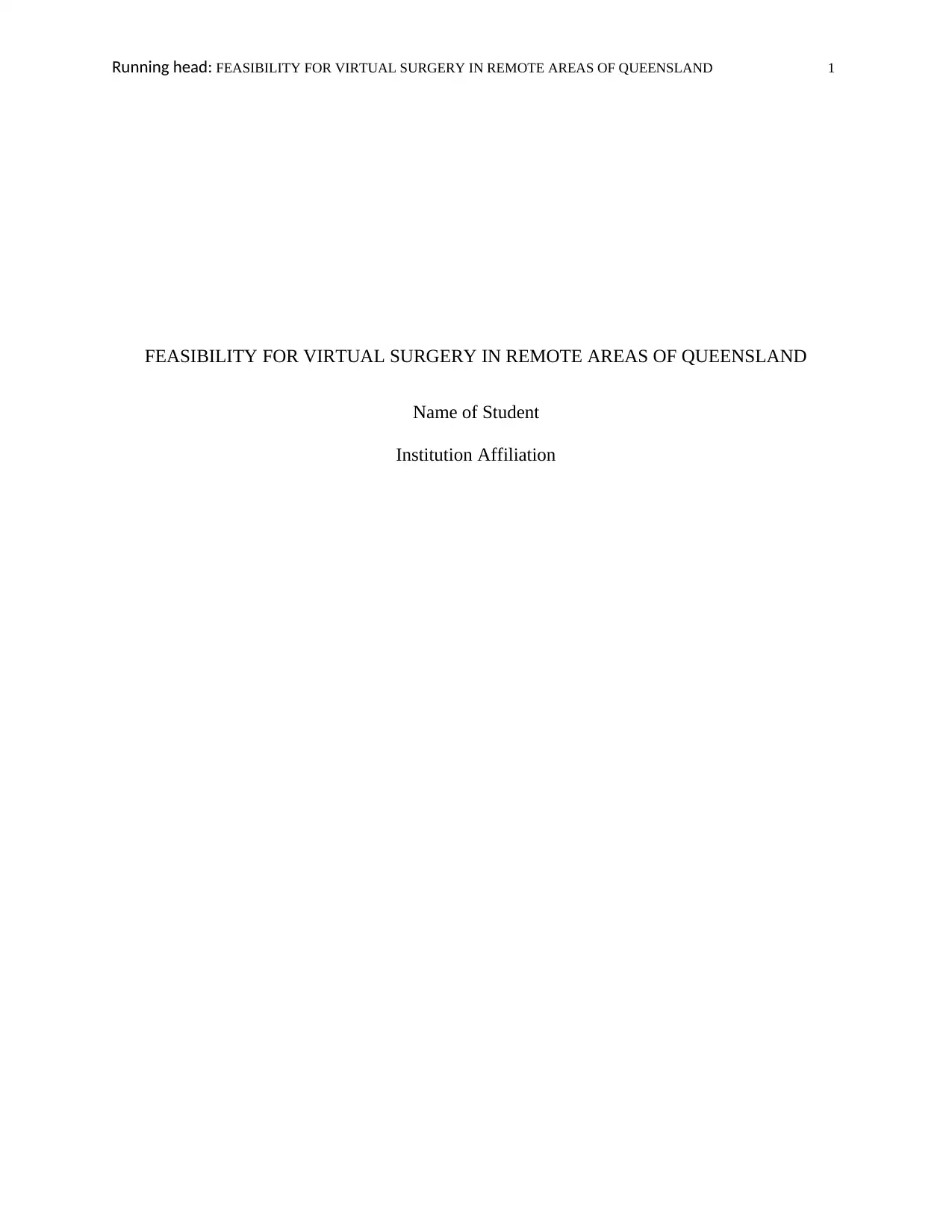
Running head: FEASIBILITY FOR VIRTUAL SURGERY IN REMOTE AREAS OF QUEENSLAND 1
FEASIBILITY FOR VIRTUAL SURGERY IN REMOTE AREAS OF QUEENSLAND
Name of Student
Institution Affiliation
FEASIBILITY FOR VIRTUAL SURGERY IN REMOTE AREAS OF QUEENSLAND
Name of Student
Institution Affiliation
Paraphrase This Document
Need a fresh take? Get an instant paraphrase of this document with our AI Paraphraser
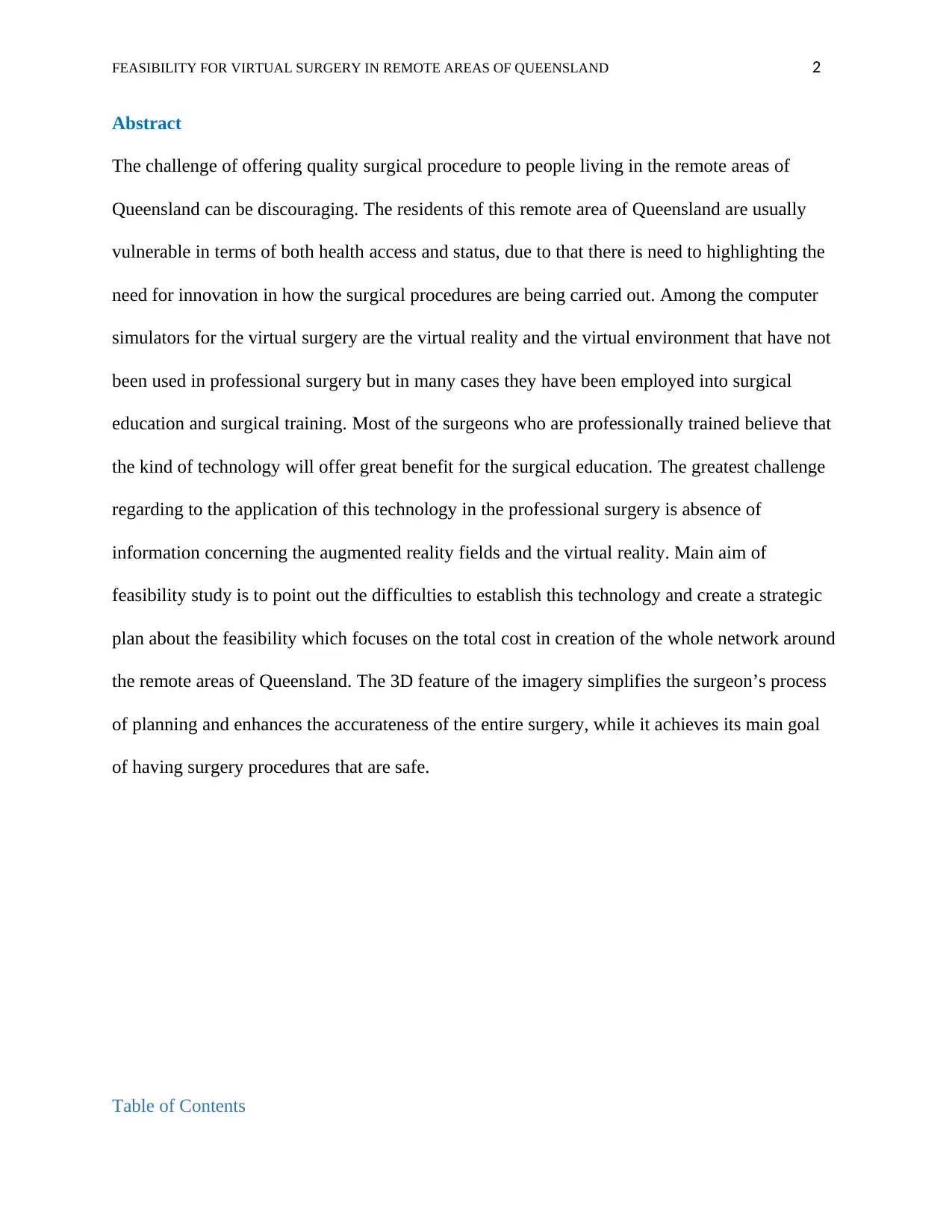
FEASIBILITY FOR VIRTUAL SURGERY IN REMOTE AREAS OF QUEENSLAND 2
Abstract
The challenge of offering quality surgical procedure to people living in the remote areas of
Queensland can be discouraging. The residents of this remote area of Queensland are usually
vulnerable in terms of both health access and status, due to that there is need to highlighting the
need for innovation in how the surgical procedures are being carried out. Among the computer
simulators for the virtual surgery are the virtual reality and the virtual environment that have not
been used in professional surgery but in many cases they have been employed into surgical
education and surgical training. Most of the surgeons who are professionally trained believe that
the kind of technology will offer great benefit for the surgical education. The greatest challenge
regarding to the application of this technology in the professional surgery is absence of
information concerning the augmented reality fields and the virtual reality. Main aim of
feasibility study is to point out the difficulties to establish this technology and create a strategic
plan about the feasibility which focuses on the total cost in creation of the whole network around
the remote areas of Queensland. The 3D feature of the imagery simplifies the surgeon’s process
of planning and enhances the accurateness of the entire surgery, while it achieves its main goal
of having surgery procedures that are safe.
Table of Contents
Abstract
The challenge of offering quality surgical procedure to people living in the remote areas of
Queensland can be discouraging. The residents of this remote area of Queensland are usually
vulnerable in terms of both health access and status, due to that there is need to highlighting the
need for innovation in how the surgical procedures are being carried out. Among the computer
simulators for the virtual surgery are the virtual reality and the virtual environment that have not
been used in professional surgery but in many cases they have been employed into surgical
education and surgical training. Most of the surgeons who are professionally trained believe that
the kind of technology will offer great benefit for the surgical education. The greatest challenge
regarding to the application of this technology in the professional surgery is absence of
information concerning the augmented reality fields and the virtual reality. Main aim of
feasibility study is to point out the difficulties to establish this technology and create a strategic
plan about the feasibility which focuses on the total cost in creation of the whole network around
the remote areas of Queensland. The 3D feature of the imagery simplifies the surgeon’s process
of planning and enhances the accurateness of the entire surgery, while it achieves its main goal
of having surgery procedures that are safe.
Table of Contents
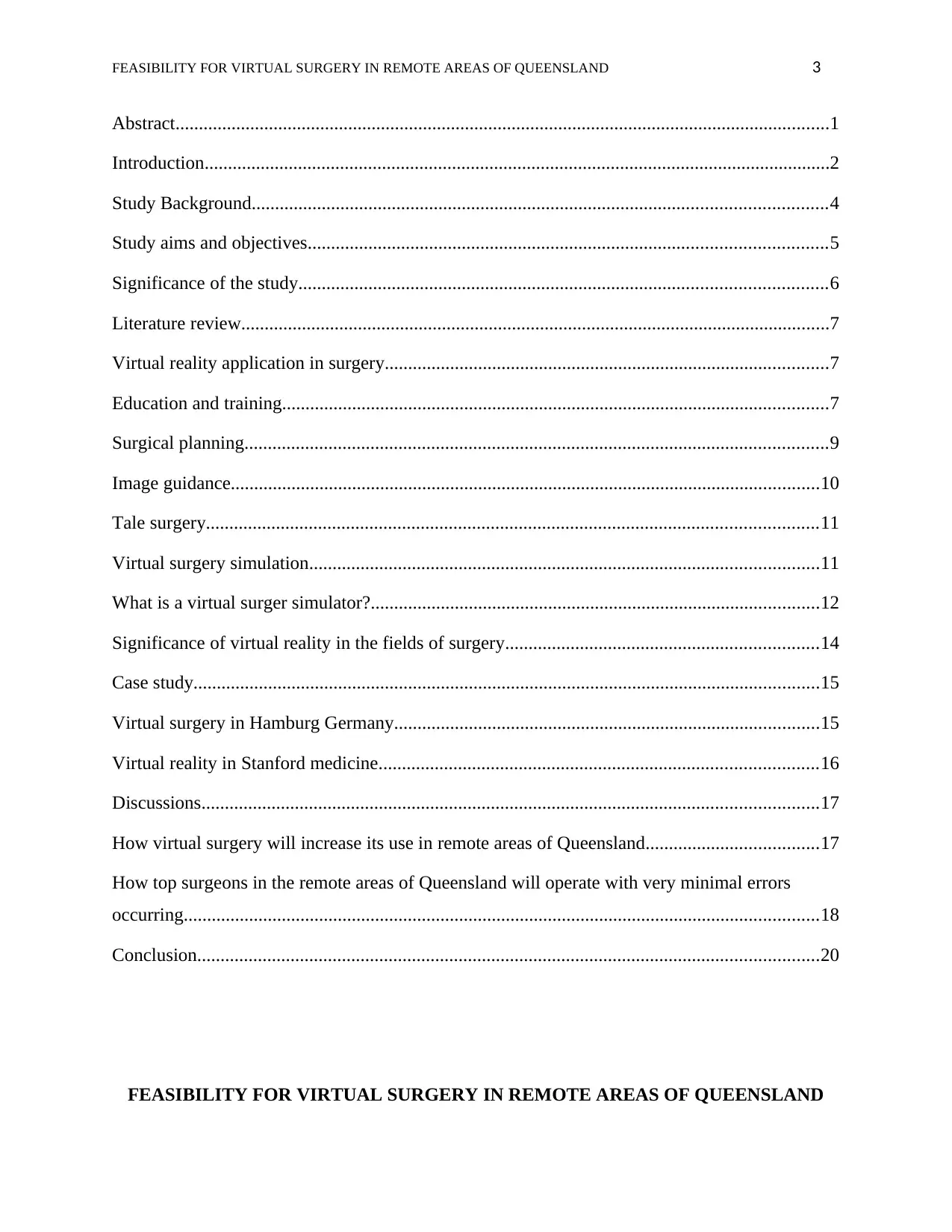
FEASIBILITY FOR VIRTUAL SURGERY IN REMOTE AREAS OF QUEENSLAND 3
Abstract............................................................................................................................................1
Introduction......................................................................................................................................2
Study Background...........................................................................................................................4
Study aims and objectives...............................................................................................................5
Significance of the study.................................................................................................................6
Literature review..............................................................................................................................7
Virtual reality application in surgery...............................................................................................7
Education and training.....................................................................................................................7
Surgical planning.............................................................................................................................9
Image guidance..............................................................................................................................10
Tale surgery...................................................................................................................................11
Virtual surgery simulation.............................................................................................................11
What is a virtual surger simulator?................................................................................................12
Significance of virtual reality in the fields of surgery...................................................................14
Case study......................................................................................................................................15
Virtual surgery in Hamburg Germany...........................................................................................15
Virtual reality in Stanford medicine..............................................................................................16
Discussions....................................................................................................................................17
How virtual surgery will increase its use in remote areas of Queensland.....................................17
How top surgeons in the remote areas of Queensland will operate with very minimal errors
occurring........................................................................................................................................18
Conclusion.....................................................................................................................................20
FEASIBILITY FOR VIRTUAL SURGERY IN REMOTE AREAS OF QUEENSLAND
Abstract............................................................................................................................................1
Introduction......................................................................................................................................2
Study Background...........................................................................................................................4
Study aims and objectives...............................................................................................................5
Significance of the study.................................................................................................................6
Literature review..............................................................................................................................7
Virtual reality application in surgery...............................................................................................7
Education and training.....................................................................................................................7
Surgical planning.............................................................................................................................9
Image guidance..............................................................................................................................10
Tale surgery...................................................................................................................................11
Virtual surgery simulation.............................................................................................................11
What is a virtual surger simulator?................................................................................................12
Significance of virtual reality in the fields of surgery...................................................................14
Case study......................................................................................................................................15
Virtual surgery in Hamburg Germany...........................................................................................15
Virtual reality in Stanford medicine..............................................................................................16
Discussions....................................................................................................................................17
How virtual surgery will increase its use in remote areas of Queensland.....................................17
How top surgeons in the remote areas of Queensland will operate with very minimal errors
occurring........................................................................................................................................18
Conclusion.....................................................................................................................................20
FEASIBILITY FOR VIRTUAL SURGERY IN REMOTE AREAS OF QUEENSLAND
⊘ This is a preview!⊘
Do you want full access?
Subscribe today to unlock all pages.

Trusted by 1+ million students worldwide
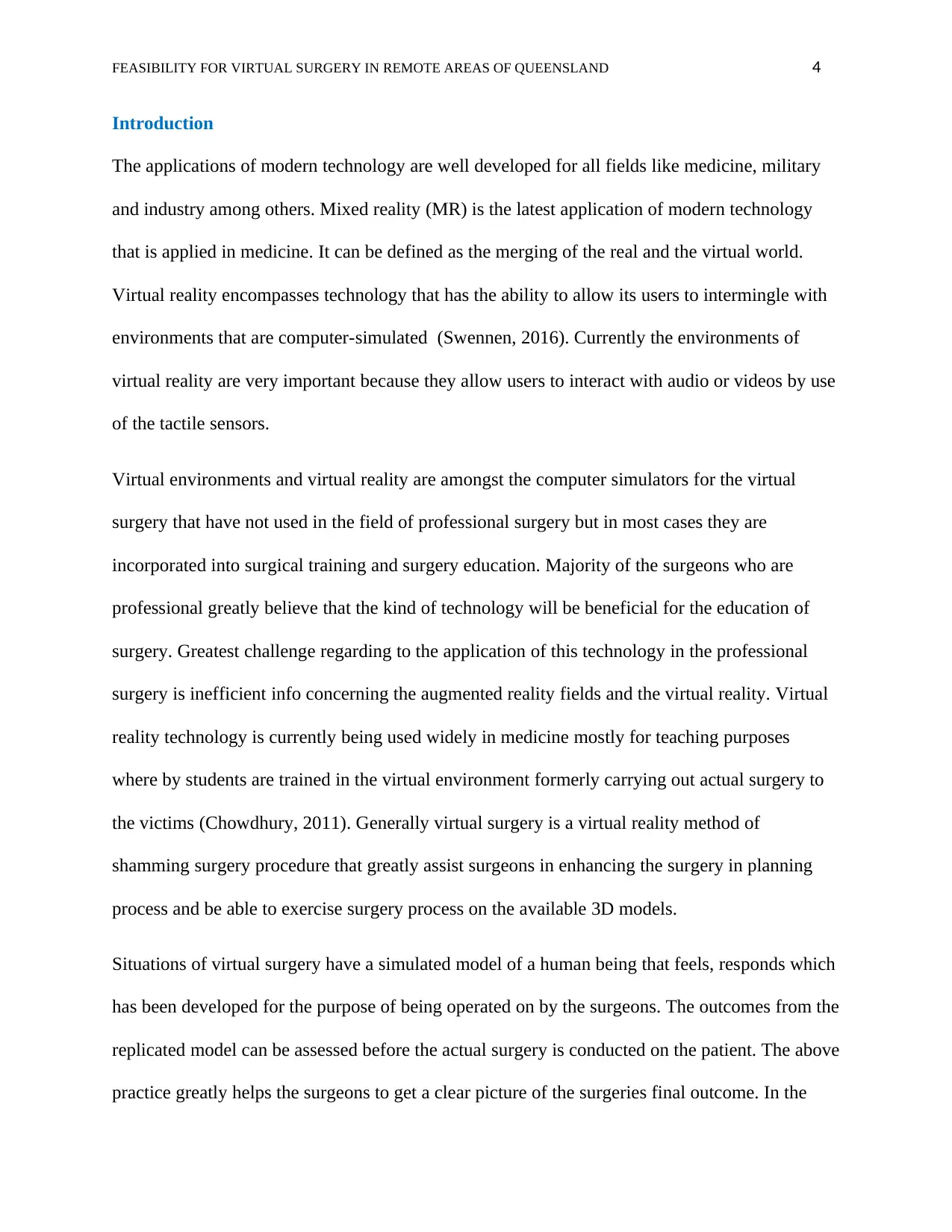
FEASIBILITY FOR VIRTUAL SURGERY IN REMOTE AREAS OF QUEENSLAND 4
Introduction
The applications of modern technology are well developed for all fields like medicine, military
and industry among others. Mixed reality (MR) is the latest application of modern technology
that is applied in medicine. It can be defined as the merging of the real and the virtual world.
Virtual reality encompasses technology that has the ability to allow its users to intermingle with
environments that are computer-simulated (Swennen, 2016). Currently the environments of
virtual reality are very important because they allow users to interact with audio or videos by use
of the tactile sensors.
Virtual environments and virtual reality are amongst the computer simulators for the virtual
surgery that have not used in the field of professional surgery but in most cases they are
incorporated into surgical training and surgery education. Majority of the surgeons who are
professional greatly believe that the kind of technology will be beneficial for the education of
surgery. Greatest challenge regarding to the application of this technology in the professional
surgery is inefficient info concerning the augmented reality fields and the virtual reality. Virtual
reality technology is currently being used widely in medicine mostly for teaching purposes
where by students are trained in the virtual environment formerly carrying out actual surgery to
the victims (Chowdhury, 2011). Generally virtual surgery is a virtual reality method of
shamming surgery procedure that greatly assist surgeons in enhancing the surgery in planning
process and be able to exercise surgery process on the available 3D models.
Situations of virtual surgery have a simulated model of a human being that feels, responds which
has been developed for the purpose of being operated on by the surgeons. The outcomes from the
replicated model can be assessed before the actual surgery is conducted on the patient. The above
practice greatly helps the surgeons to get a clear picture of the surgeries final outcome. In the
Introduction
The applications of modern technology are well developed for all fields like medicine, military
and industry among others. Mixed reality (MR) is the latest application of modern technology
that is applied in medicine. It can be defined as the merging of the real and the virtual world.
Virtual reality encompasses technology that has the ability to allow its users to intermingle with
environments that are computer-simulated (Swennen, 2016). Currently the environments of
virtual reality are very important because they allow users to interact with audio or videos by use
of the tactile sensors.
Virtual environments and virtual reality are amongst the computer simulators for the virtual
surgery that have not used in the field of professional surgery but in most cases they are
incorporated into surgical training and surgery education. Majority of the surgeons who are
professional greatly believe that the kind of technology will be beneficial for the education of
surgery. Greatest challenge regarding to the application of this technology in the professional
surgery is inefficient info concerning the augmented reality fields and the virtual reality. Virtual
reality technology is currently being used widely in medicine mostly for teaching purposes
where by students are trained in the virtual environment formerly carrying out actual surgery to
the victims (Chowdhury, 2011). Generally virtual surgery is a virtual reality method of
shamming surgery procedure that greatly assist surgeons in enhancing the surgery in planning
process and be able to exercise surgery process on the available 3D models.
Situations of virtual surgery have a simulated model of a human being that feels, responds which
has been developed for the purpose of being operated on by the surgeons. The outcomes from the
replicated model can be assessed before the actual surgery is conducted on the patient. The above
practice greatly helps the surgeons to get a clear picture of the surgeries final outcome. In the
Paraphrase This Document
Need a fresh take? Get an instant paraphrase of this document with our AI Paraphraser
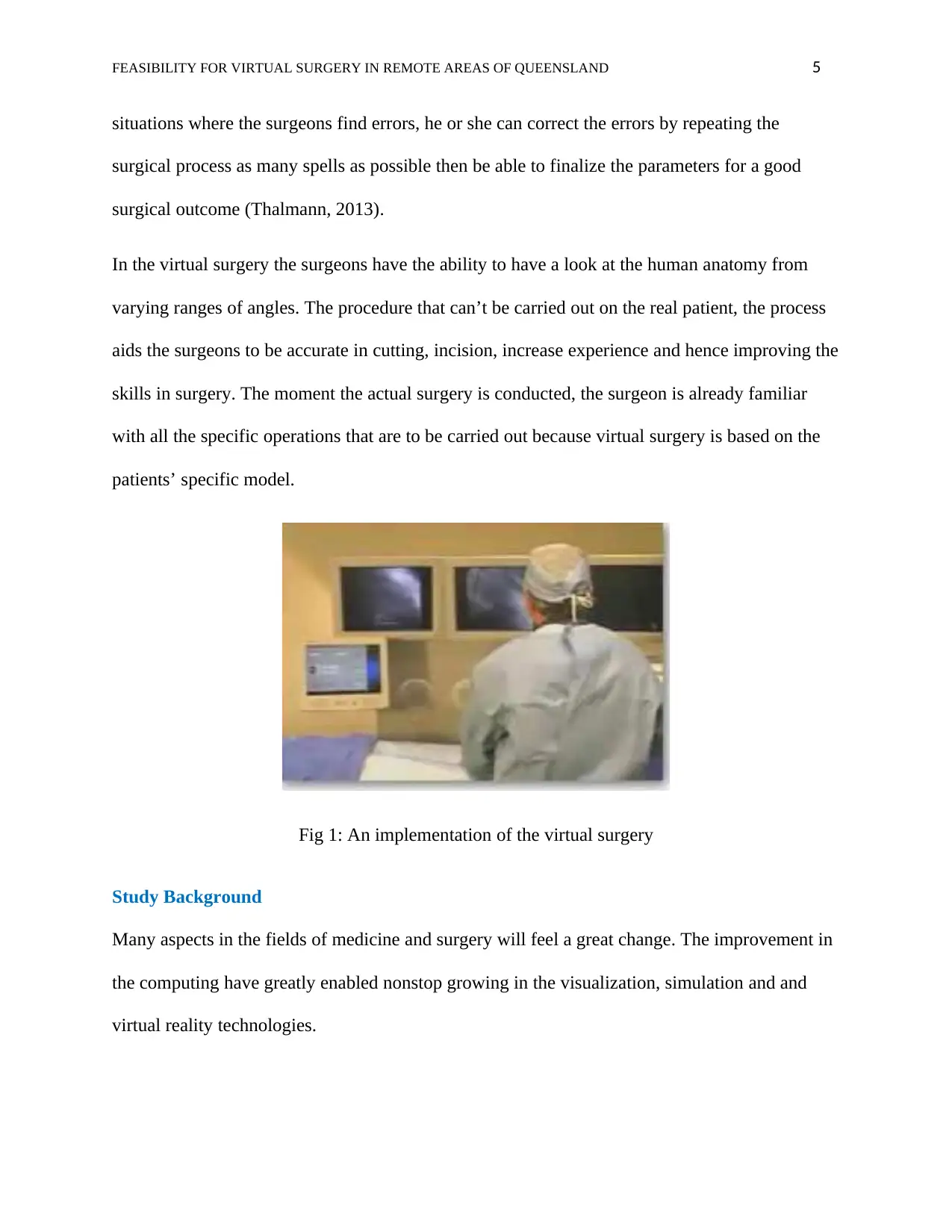
FEASIBILITY FOR VIRTUAL SURGERY IN REMOTE AREAS OF QUEENSLAND 5
situations where the surgeons find errors, he or she can correct the errors by repeating the
surgical process as many spells as possible then be able to finalize the parameters for a good
surgical outcome (Thalmann, 2013).
In the virtual surgery the surgeons have the ability to have a look at the human anatomy from
varying ranges of angles. The procedure that can’t be carried out on the real patient, the process
aids the surgeons to be accurate in cutting, incision, increase experience and hence improving the
skills in surgery. The moment the actual surgery is conducted, the surgeon is already familiar
with all the specific operations that are to be carried out because virtual surgery is based on the
patients’ specific model.
Fig 1: An implementation of the virtual surgery
Study Background
Many aspects in the fields of medicine and surgery will feel a great change. The improvement in
the computing have greatly enabled nonstop growing in the visualization, simulation and and
virtual reality technologies.
situations where the surgeons find errors, he or she can correct the errors by repeating the
surgical process as many spells as possible then be able to finalize the parameters for a good
surgical outcome (Thalmann, 2013).
In the virtual surgery the surgeons have the ability to have a look at the human anatomy from
varying ranges of angles. The procedure that can’t be carried out on the real patient, the process
aids the surgeons to be accurate in cutting, incision, increase experience and hence improving the
skills in surgery. The moment the actual surgery is conducted, the surgeon is already familiar
with all the specific operations that are to be carried out because virtual surgery is based on the
patients’ specific model.
Fig 1: An implementation of the virtual surgery
Study Background
Many aspects in the fields of medicine and surgery will feel a great change. The improvement in
the computing have greatly enabled nonstop growing in the visualization, simulation and and
virtual reality technologies.
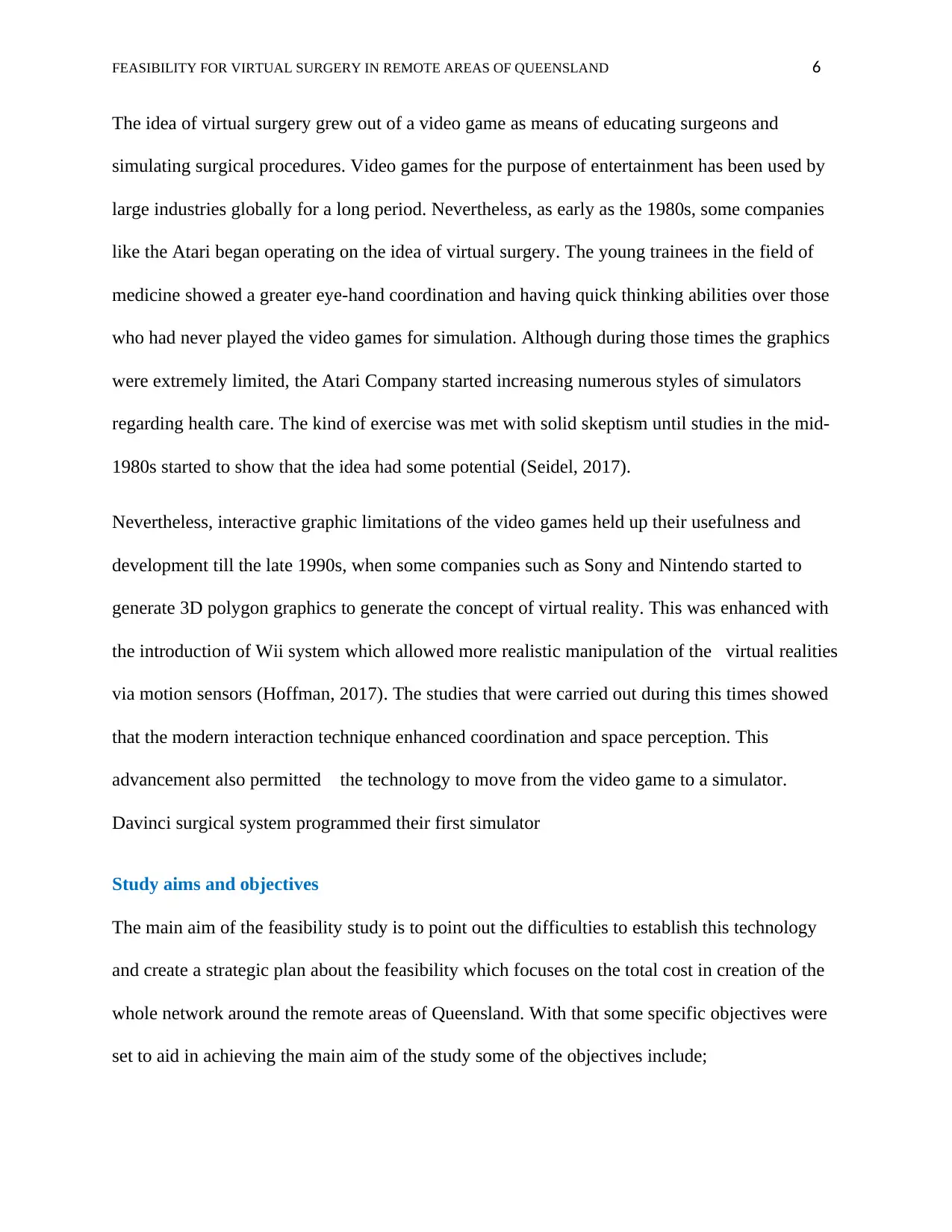
FEASIBILITY FOR VIRTUAL SURGERY IN REMOTE AREAS OF QUEENSLAND 6
The idea of virtual surgery grew out of a video game as means of educating surgeons and
simulating surgical procedures. Video games for the purpose of entertainment has been used by
large industries globally for a long period. Nevertheless, as early as the 1980s, some companies
like the Atari began operating on the idea of virtual surgery. The young trainees in the field of
medicine showed a greater eye-hand coordination and having quick thinking abilities over those
who had never played the video games for simulation. Although during those times the graphics
were extremely limited, the Atari Company started increasing numerous styles of simulators
regarding health care. The kind of exercise was met with solid skeptism until studies in the mid-
1980s started to show that the idea had some potential (Seidel, 2017).
Nevertheless, interactive graphic limitations of the video games held up their usefulness and
development till the late 1990s, when some companies such as Sony and Nintendo started to
generate 3D polygon graphics to generate the concept of virtual reality. This was enhanced with
the introduction of Wii system which allowed more realistic manipulation of the virtual realities
via motion sensors (Hoffman, 2017). The studies that were carried out during this times showed
that the modern interaction technique enhanced coordination and space perception. This
advancement also permitted the technology to move from the video game to a simulator.
Davinci surgical system programmed their first simulator
Study aims and objectives
The main aim of the feasibility study is to point out the difficulties to establish this technology
and create a strategic plan about the feasibility which focuses on the total cost in creation of the
whole network around the remote areas of Queensland. With that some specific objectives were
set to aid in achieving the main aim of the study some of the objectives include;
The idea of virtual surgery grew out of a video game as means of educating surgeons and
simulating surgical procedures. Video games for the purpose of entertainment has been used by
large industries globally for a long period. Nevertheless, as early as the 1980s, some companies
like the Atari began operating on the idea of virtual surgery. The young trainees in the field of
medicine showed a greater eye-hand coordination and having quick thinking abilities over those
who had never played the video games for simulation. Although during those times the graphics
were extremely limited, the Atari Company started increasing numerous styles of simulators
regarding health care. The kind of exercise was met with solid skeptism until studies in the mid-
1980s started to show that the idea had some potential (Seidel, 2017).
Nevertheless, interactive graphic limitations of the video games held up their usefulness and
development till the late 1990s, when some companies such as Sony and Nintendo started to
generate 3D polygon graphics to generate the concept of virtual reality. This was enhanced with
the introduction of Wii system which allowed more realistic manipulation of the virtual realities
via motion sensors (Hoffman, 2017). The studies that were carried out during this times showed
that the modern interaction technique enhanced coordination and space perception. This
advancement also permitted the technology to move from the video game to a simulator.
Davinci surgical system programmed their first simulator
Study aims and objectives
The main aim of the feasibility study is to point out the difficulties to establish this technology
and create a strategic plan about the feasibility which focuses on the total cost in creation of the
whole network around the remote areas of Queensland. With that some specific objectives were
set to aid in achieving the main aim of the study some of the objectives include;
⊘ This is a preview!⊘
Do you want full access?
Subscribe today to unlock all pages.

Trusted by 1+ million students worldwide
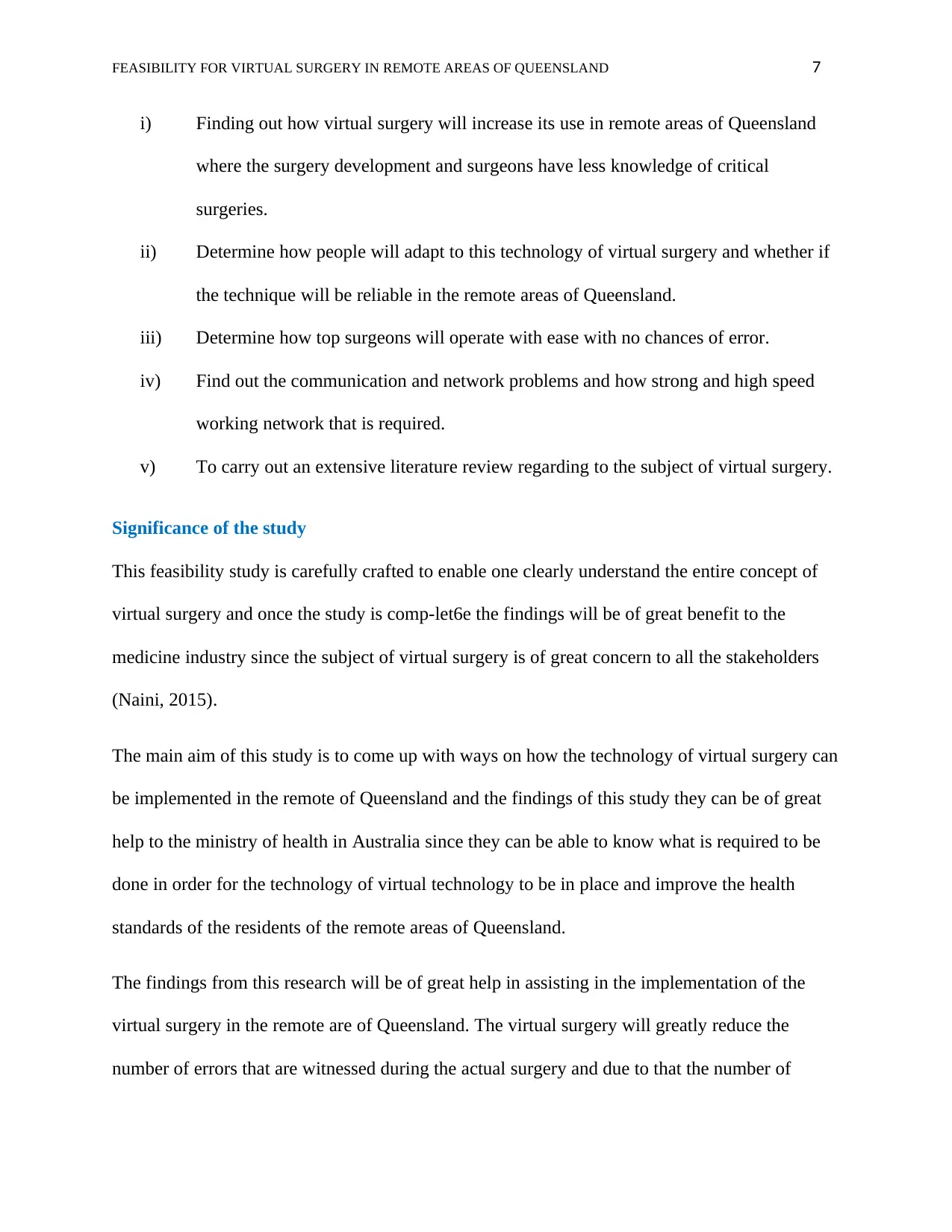
FEASIBILITY FOR VIRTUAL SURGERY IN REMOTE AREAS OF QUEENSLAND 7
i) Finding out how virtual surgery will increase its use in remote areas of Queensland
where the surgery development and surgeons have less knowledge of critical
surgeries.
ii) Determine how people will adapt to this technology of virtual surgery and whether if
the technique will be reliable in the remote areas of Queensland.
iii) Determine how top surgeons will operate with ease with no chances of error.
iv) Find out the communication and network problems and how strong and high speed
working network that is required.
v) To carry out an extensive literature review regarding to the subject of virtual surgery.
Significance of the study
This feasibility study is carefully crafted to enable one clearly understand the entire concept of
virtual surgery and once the study is comp-let6e the findings will be of great benefit to the
medicine industry since the subject of virtual surgery is of great concern to all the stakeholders
(Naini, 2015).
The main aim of this study is to come up with ways on how the technology of virtual surgery can
be implemented in the remote of Queensland and the findings of this study they can be of great
help to the ministry of health in Australia since they can be able to know what is required to be
done in order for the technology of virtual technology to be in place and improve the health
standards of the residents of the remote areas of Queensland.
The findings from this research will be of great help in assisting in the implementation of the
virtual surgery in the remote are of Queensland. The virtual surgery will greatly reduce the
number of errors that are witnessed during the actual surgery and due to that the number of
i) Finding out how virtual surgery will increase its use in remote areas of Queensland
where the surgery development and surgeons have less knowledge of critical
surgeries.
ii) Determine how people will adapt to this technology of virtual surgery and whether if
the technique will be reliable in the remote areas of Queensland.
iii) Determine how top surgeons will operate with ease with no chances of error.
iv) Find out the communication and network problems and how strong and high speed
working network that is required.
v) To carry out an extensive literature review regarding to the subject of virtual surgery.
Significance of the study
This feasibility study is carefully crafted to enable one clearly understand the entire concept of
virtual surgery and once the study is comp-let6e the findings will be of great benefit to the
medicine industry since the subject of virtual surgery is of great concern to all the stakeholders
(Naini, 2015).
The main aim of this study is to come up with ways on how the technology of virtual surgery can
be implemented in the remote of Queensland and the findings of this study they can be of great
help to the ministry of health in Australia since they can be able to know what is required to be
done in order for the technology of virtual technology to be in place and improve the health
standards of the residents of the remote areas of Queensland.
The findings from this research will be of great help in assisting in the implementation of the
virtual surgery in the remote are of Queensland. The virtual surgery will greatly reduce the
number of errors that are witnessed during the actual surgery and due to that the number of
Paraphrase This Document
Need a fresh take? Get an instant paraphrase of this document with our AI Paraphraser
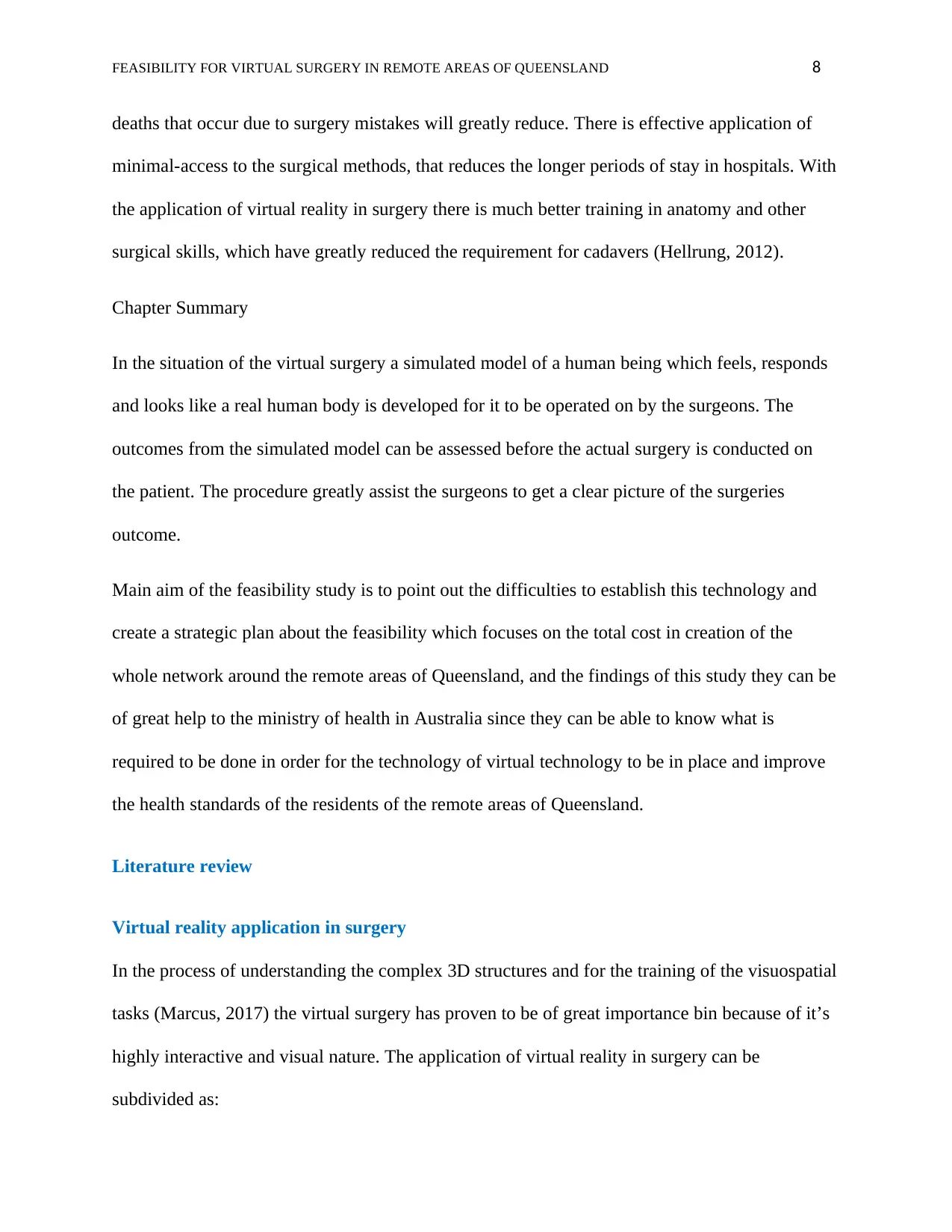
FEASIBILITY FOR VIRTUAL SURGERY IN REMOTE AREAS OF QUEENSLAND 8
deaths that occur due to surgery mistakes will greatly reduce. There is effective application of
minimal-access to the surgical methods, that reduces the longer periods of stay in hospitals. With
the application of virtual reality in surgery there is much better training in anatomy and other
surgical skills, which have greatly reduced the requirement for cadavers (Hellrung, 2012).
Chapter Summary
In the situation of the virtual surgery a simulated model of a human being which feels, responds
and looks like a real human body is developed for it to be operated on by the surgeons. The
outcomes from the simulated model can be assessed before the actual surgery is conducted on
the patient. The procedure greatly assist the surgeons to get a clear picture of the surgeries
outcome.
Main aim of the feasibility study is to point out the difficulties to establish this technology and
create a strategic plan about the feasibility which focuses on the total cost in creation of the
whole network around the remote areas of Queensland, and the findings of this study they can be
of great help to the ministry of health in Australia since they can be able to know what is
required to be done in order for the technology of virtual technology to be in place and improve
the health standards of the residents of the remote areas of Queensland.
Literature review
Virtual reality application in surgery
In the process of understanding the complex 3D structures and for the training of the visuospatial
tasks (Marcus, 2017) the virtual surgery has proven to be of great importance bin because of it’s
highly interactive and visual nature. The application of virtual reality in surgery can be
subdivided as:
deaths that occur due to surgery mistakes will greatly reduce. There is effective application of
minimal-access to the surgical methods, that reduces the longer periods of stay in hospitals. With
the application of virtual reality in surgery there is much better training in anatomy and other
surgical skills, which have greatly reduced the requirement for cadavers (Hellrung, 2012).
Chapter Summary
In the situation of the virtual surgery a simulated model of a human being which feels, responds
and looks like a real human body is developed for it to be operated on by the surgeons. The
outcomes from the simulated model can be assessed before the actual surgery is conducted on
the patient. The procedure greatly assist the surgeons to get a clear picture of the surgeries
outcome.
Main aim of the feasibility study is to point out the difficulties to establish this technology and
create a strategic plan about the feasibility which focuses on the total cost in creation of the
whole network around the remote areas of Queensland, and the findings of this study they can be
of great help to the ministry of health in Australia since they can be able to know what is
required to be done in order for the technology of virtual technology to be in place and improve
the health standards of the residents of the remote areas of Queensland.
Literature review
Virtual reality application in surgery
In the process of understanding the complex 3D structures and for the training of the visuospatial
tasks (Marcus, 2017) the virtual surgery has proven to be of great importance bin because of it’s
highly interactive and visual nature. The application of virtual reality in surgery can be
subdivided as:
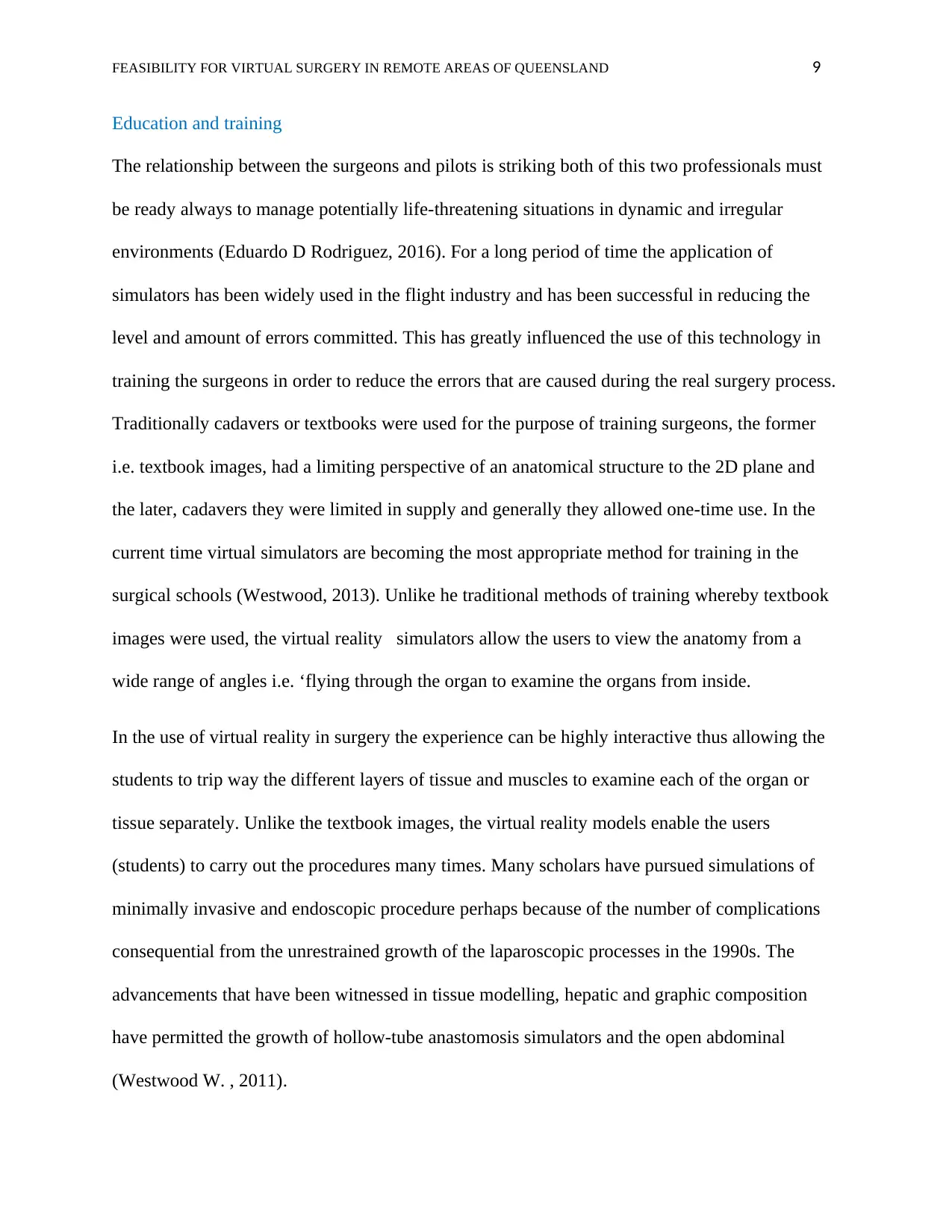
FEASIBILITY FOR VIRTUAL SURGERY IN REMOTE AREAS OF QUEENSLAND 9
Education and training
The relationship between the surgeons and pilots is striking both of this two professionals must
be ready always to manage potentially life-threatening situations in dynamic and irregular
environments (Eduardo D Rodriguez, 2016). For a long period of time the application of
simulators has been widely used in the flight industry and has been successful in reducing the
level and amount of errors committed. This has greatly influenced the use of this technology in
training the surgeons in order to reduce the errors that are caused during the real surgery process.
Traditionally cadavers or textbooks were used for the purpose of training surgeons, the former
i.e. textbook images, had a limiting perspective of an anatomical structure to the 2D plane and
the later, cadavers they were limited in supply and generally they allowed one-time use. In the
current time virtual simulators are becoming the most appropriate method for training in the
surgical schools (Westwood, 2013). Unlike he traditional methods of training whereby textbook
images were used, the virtual reality simulators allow the users to view the anatomy from a
wide range of angles i.e. ‘flying through the organ to examine the organs from inside.
In the use of virtual reality in surgery the experience can be highly interactive thus allowing the
students to trip way the different layers of tissue and muscles to examine each of the organ or
tissue separately. Unlike the textbook images, the virtual reality models enable the users
(students) to carry out the procedures many times. Many scholars have pursued simulations of
minimally invasive and endoscopic procedure perhaps because of the number of complications
consequential from the unrestrained growth of the laparoscopic processes in the 1990s. The
advancements that have been witnessed in tissue modelling, hepatic and graphic composition
have permitted the growth of hollow-tube anastomosis simulators and the open abdominal
(Westwood W. , 2011).
Education and training
The relationship between the surgeons and pilots is striking both of this two professionals must
be ready always to manage potentially life-threatening situations in dynamic and irregular
environments (Eduardo D Rodriguez, 2016). For a long period of time the application of
simulators has been widely used in the flight industry and has been successful in reducing the
level and amount of errors committed. This has greatly influenced the use of this technology in
training the surgeons in order to reduce the errors that are caused during the real surgery process.
Traditionally cadavers or textbooks were used for the purpose of training surgeons, the former
i.e. textbook images, had a limiting perspective of an anatomical structure to the 2D plane and
the later, cadavers they were limited in supply and generally they allowed one-time use. In the
current time virtual simulators are becoming the most appropriate method for training in the
surgical schools (Westwood, 2013). Unlike he traditional methods of training whereby textbook
images were used, the virtual reality simulators allow the users to view the anatomy from a
wide range of angles i.e. ‘flying through the organ to examine the organs from inside.
In the use of virtual reality in surgery the experience can be highly interactive thus allowing the
students to trip way the different layers of tissue and muscles to examine each of the organ or
tissue separately. Unlike the textbook images, the virtual reality models enable the users
(students) to carry out the procedures many times. Many scholars have pursued simulations of
minimally invasive and endoscopic procedure perhaps because of the number of complications
consequential from the unrestrained growth of the laparoscopic processes in the 1990s. The
advancements that have been witnessed in tissue modelling, hepatic and graphic composition
have permitted the growth of hollow-tube anastomosis simulators and the open abdominal
(Westwood W. , 2011).
⊘ This is a preview!⊘
Do you want full access?
Subscribe today to unlock all pages.

Trusted by 1+ million students worldwide
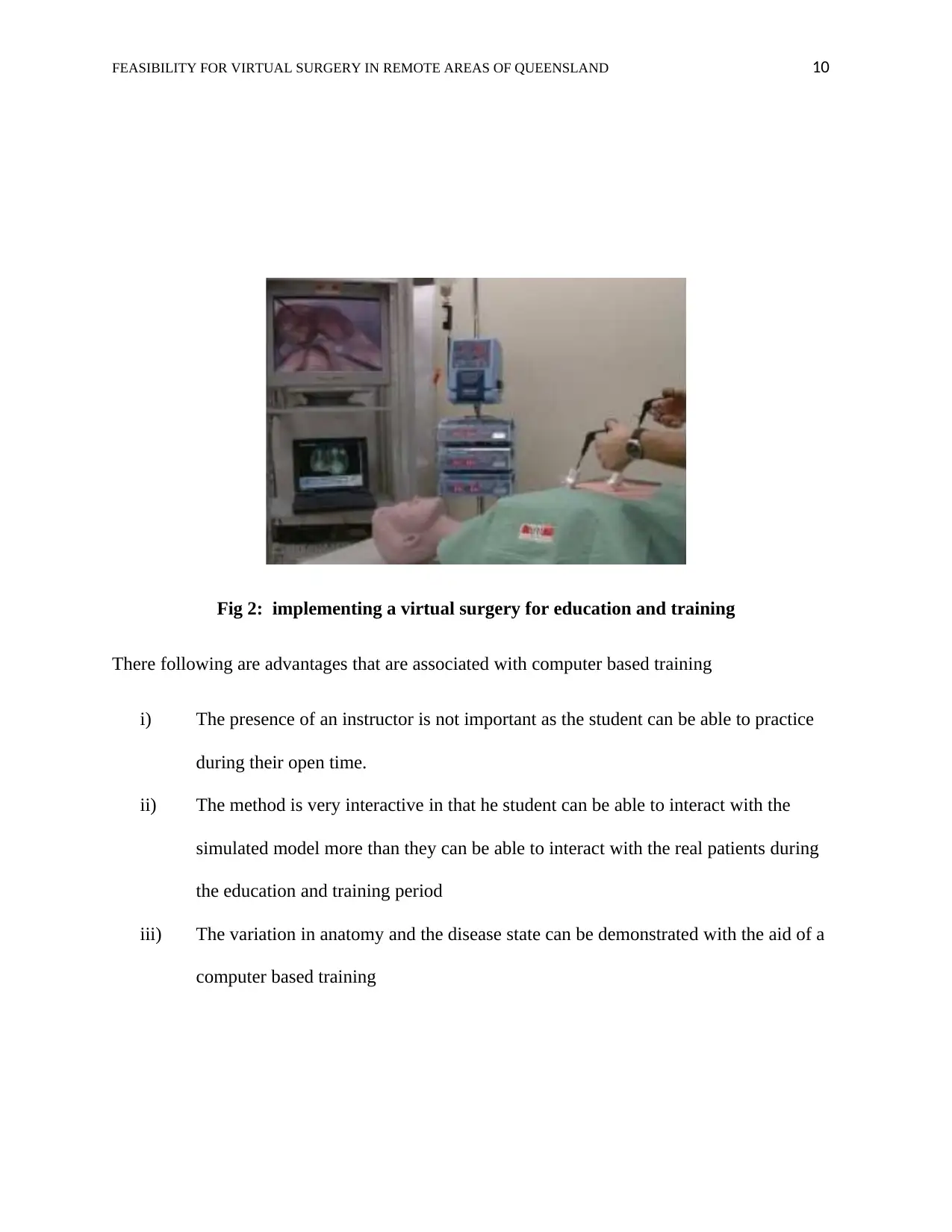
FEASIBILITY FOR VIRTUAL SURGERY IN REMOTE AREAS OF QUEENSLAND 10
Fig 2: implementing a virtual surgery for education and training
There following are advantages that are associated with computer based training
i) The presence of an instructor is not important as the student can be able to practice
during their open time.
ii) The method is very interactive in that he student can be able to interact with the
simulated model more than they can be able to interact with the real patients during
the education and training period
iii) The variation in anatomy and the disease state can be demonstrated with the aid of a
computer based training
Fig 2: implementing a virtual surgery for education and training
There following are advantages that are associated with computer based training
i) The presence of an instructor is not important as the student can be able to practice
during their open time.
ii) The method is very interactive in that he student can be able to interact with the
simulated model more than they can be able to interact with the real patients during
the education and training period
iii) The variation in anatomy and the disease state can be demonstrated with the aid of a
computer based training
Paraphrase This Document
Need a fresh take? Get an instant paraphrase of this document with our AI Paraphraser
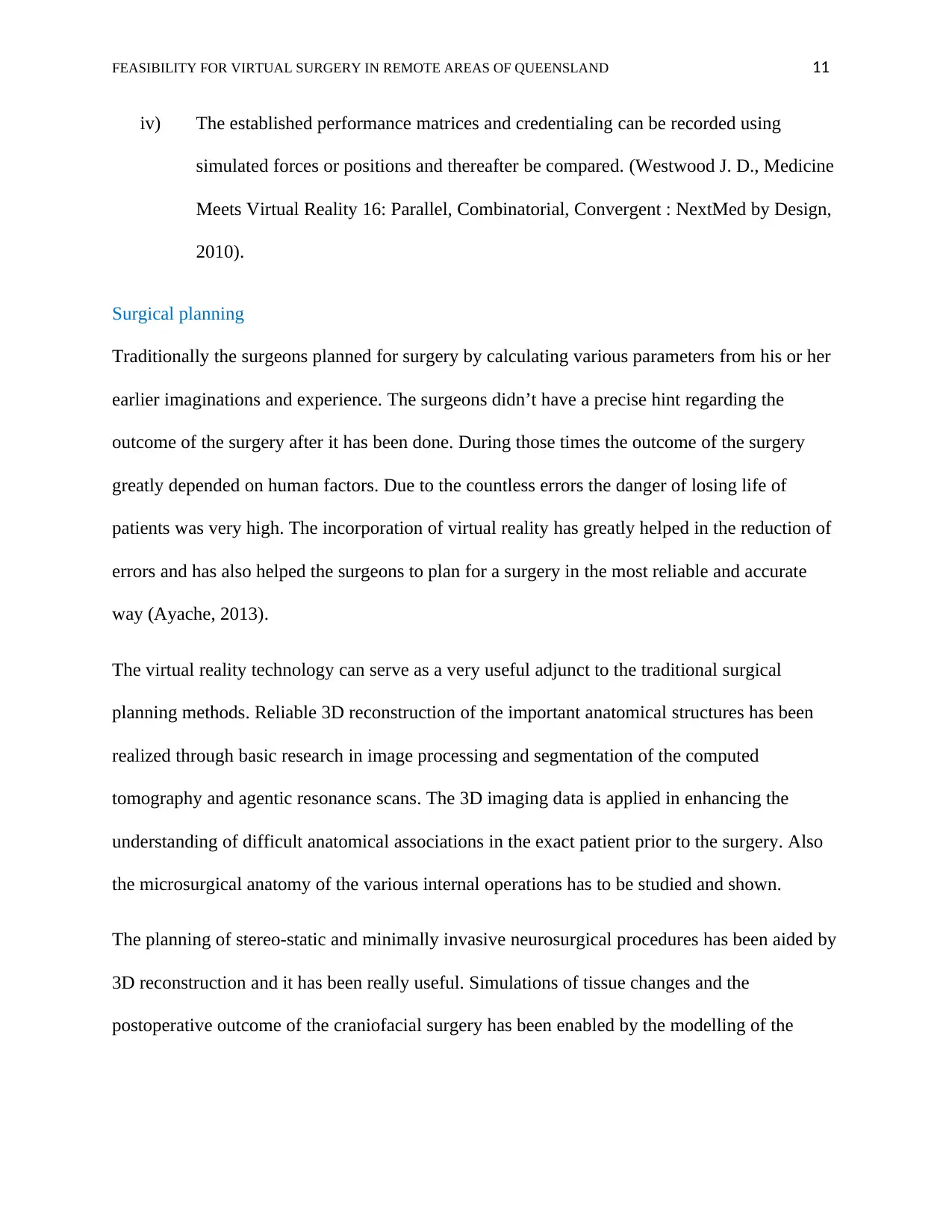
FEASIBILITY FOR VIRTUAL SURGERY IN REMOTE AREAS OF QUEENSLAND 11
iv) The established performance matrices and credentialing can be recorded using
simulated forces or positions and thereafter be compared. (Westwood J. D., Medicine
Meets Virtual Reality 16: Parallel, Combinatorial, Convergent : NextMed by Design,
2010).
Surgical planning
Traditionally the surgeons planned for surgery by calculating various parameters from his or her
earlier imaginations and experience. The surgeons didn’t have a precise hint regarding the
outcome of the surgery after it has been done. During those times the outcome of the surgery
greatly depended on human factors. Due to the countless errors the danger of losing life of
patients was very high. The incorporation of virtual reality has greatly helped in the reduction of
errors and has also helped the surgeons to plan for a surgery in the most reliable and accurate
way (Ayache, 2013).
The virtual reality technology can serve as a very useful adjunct to the traditional surgical
planning methods. Reliable 3D reconstruction of the important anatomical structures has been
realized through basic research in image processing and segmentation of the computed
tomography and agentic resonance scans. The 3D imaging data is applied in enhancing the
understanding of difficult anatomical associations in the exact patient prior to the surgery. Also
the microsurgical anatomy of the various internal operations has to be studied and shown.
The planning of stereo-static and minimally invasive neurosurgical procedures has been aided by
3D reconstruction and it has been really useful. Simulations of tissue changes and the
postoperative outcome of the craniofacial surgery has been enabled by the modelling of the
iv) The established performance matrices and credentialing can be recorded using
simulated forces or positions and thereafter be compared. (Westwood J. D., Medicine
Meets Virtual Reality 16: Parallel, Combinatorial, Convergent : NextMed by Design,
2010).
Surgical planning
Traditionally the surgeons planned for surgery by calculating various parameters from his or her
earlier imaginations and experience. The surgeons didn’t have a precise hint regarding the
outcome of the surgery after it has been done. During those times the outcome of the surgery
greatly depended on human factors. Due to the countless errors the danger of losing life of
patients was very high. The incorporation of virtual reality has greatly helped in the reduction of
errors and has also helped the surgeons to plan for a surgery in the most reliable and accurate
way (Ayache, 2013).
The virtual reality technology can serve as a very useful adjunct to the traditional surgical
planning methods. Reliable 3D reconstruction of the important anatomical structures has been
realized through basic research in image processing and segmentation of the computed
tomography and agentic resonance scans. The 3D imaging data is applied in enhancing the
understanding of difficult anatomical associations in the exact patient prior to the surgery. Also
the microsurgical anatomy of the various internal operations has to be studied and shown.
The planning of stereo-static and minimally invasive neurosurgical procedures has been aided by
3D reconstruction and it has been really useful. Simulations of tissue changes and the
postoperative outcome of the craniofacial surgery has been enabled by the modelling of the
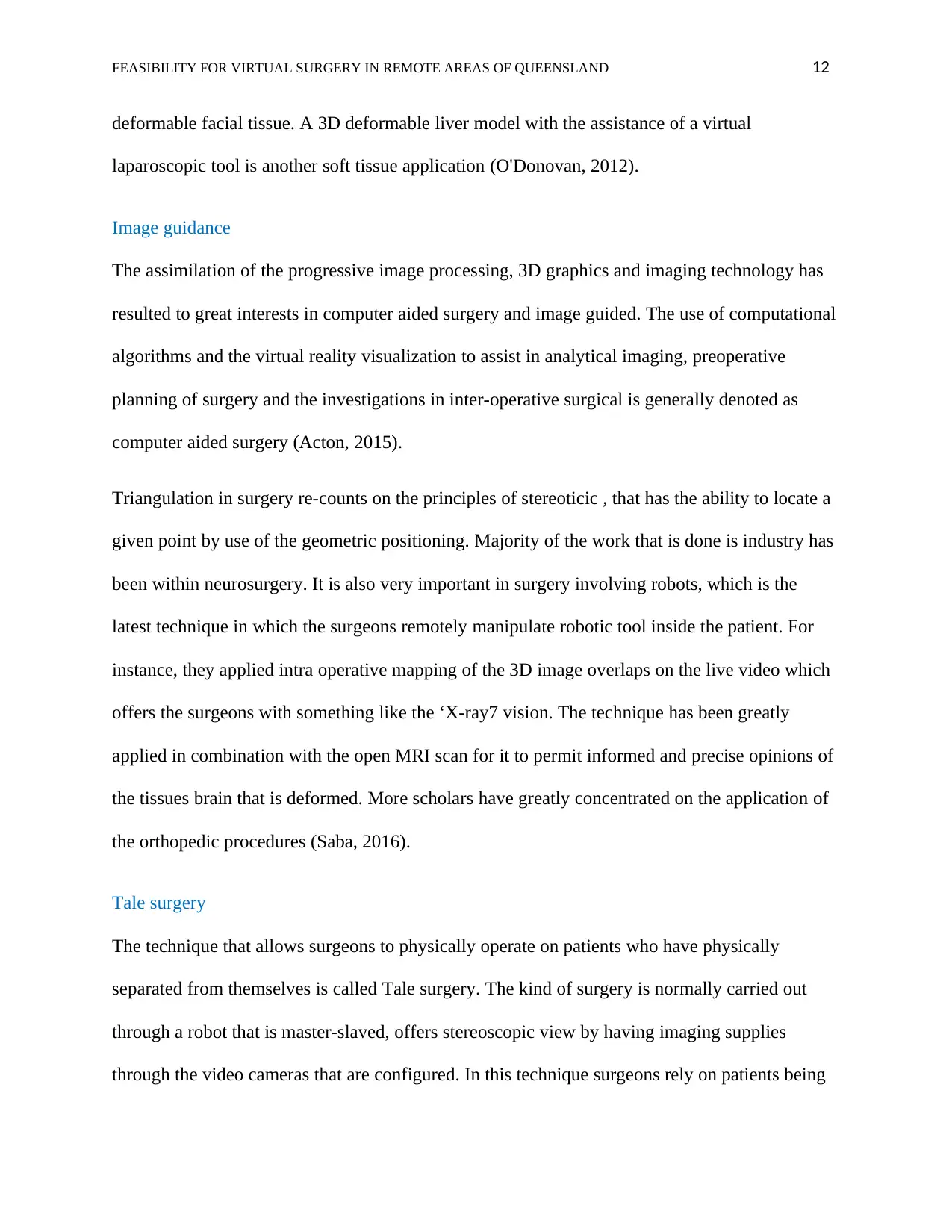
FEASIBILITY FOR VIRTUAL SURGERY IN REMOTE AREAS OF QUEENSLAND 12
deformable facial tissue. A 3D deformable liver model with the assistance of a virtual
laparoscopic tool is another soft tissue application (O'Donovan, 2012).
Image guidance
The assimilation of the progressive image processing, 3D graphics and imaging technology has
resulted to great interests in computer aided surgery and image guided. The use of computational
algorithms and the virtual reality visualization to assist in analytical imaging, preoperative
planning of surgery and the investigations in inter-operative surgical is generally denoted as
computer aided surgery (Acton, 2015).
Triangulation in surgery re-counts on the principles of stereoticic , that has the ability to locate a
given point by use of the geometric positioning. Majority of the work that is done is industry has
been within neurosurgery. It is also very important in surgery involving robots, which is the
latest technique in which the surgeons remotely manipulate robotic tool inside the patient. For
instance, they applied intra operative mapping of the 3D image overlaps on the live video which
offers the surgeons with something like the ‘X-ray7 vision. The technique has been greatly
applied in combination with the open MRI scan for it to permit informed and precise opinions of
the tissues brain that is deformed. More scholars have greatly concentrated on the application of
the orthopedic procedures (Saba, 2016).
Tale surgery
The technique that allows surgeons to physically operate on patients who have physically
separated from themselves is called Tale surgery. The kind of surgery is normally carried out
through a robot that is master-slaved, offers stereoscopic view by having imaging supplies
through the video cameras that are configured. In this technique surgeons rely on patients being
deformable facial tissue. A 3D deformable liver model with the assistance of a virtual
laparoscopic tool is another soft tissue application (O'Donovan, 2012).
Image guidance
The assimilation of the progressive image processing, 3D graphics and imaging technology has
resulted to great interests in computer aided surgery and image guided. The use of computational
algorithms and the virtual reality visualization to assist in analytical imaging, preoperative
planning of surgery and the investigations in inter-operative surgical is generally denoted as
computer aided surgery (Acton, 2015).
Triangulation in surgery re-counts on the principles of stereoticic , that has the ability to locate a
given point by use of the geometric positioning. Majority of the work that is done is industry has
been within neurosurgery. It is also very important in surgery involving robots, which is the
latest technique in which the surgeons remotely manipulate robotic tool inside the patient. For
instance, they applied intra operative mapping of the 3D image overlaps on the live video which
offers the surgeons with something like the ‘X-ray7 vision. The technique has been greatly
applied in combination with the open MRI scan for it to permit informed and precise opinions of
the tissues brain that is deformed. More scholars have greatly concentrated on the application of
the orthopedic procedures (Saba, 2016).
Tale surgery
The technique that allows surgeons to physically operate on patients who have physically
separated from themselves is called Tale surgery. The kind of surgery is normally carried out
through a robot that is master-slaved, offers stereoscopic view by having imaging supplies
through the video cameras that are configured. In this technique surgeons rely on patients being
⊘ This is a preview!⊘
Do you want full access?
Subscribe today to unlock all pages.

Trusted by 1+ million students worldwide
1 out of 27
Related Documents
Your All-in-One AI-Powered Toolkit for Academic Success.
+13062052269
info@desklib.com
Available 24*7 on WhatsApp / Email
![[object Object]](/_next/static/media/star-bottom.7253800d.svg)
Unlock your academic potential
Copyright © 2020–2025 A2Z Services. All Rights Reserved. Developed and managed by ZUCOL.





